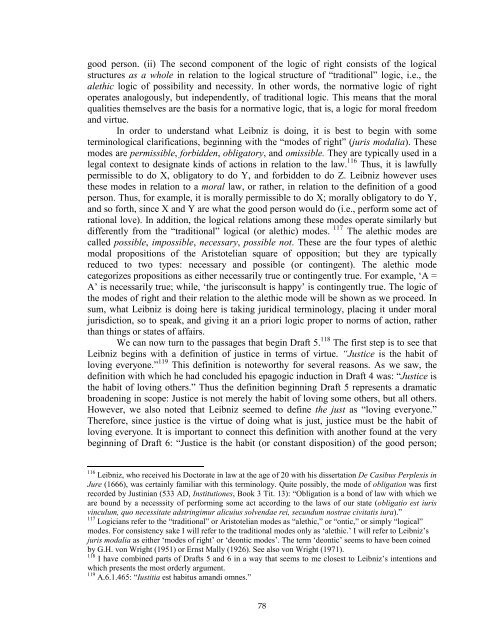Stony Brook University
Stony Brook University
Stony Brook University
Create successful ePaper yourself
Turn your PDF publications into a flip-book with our unique Google optimized e-Paper software.
good person. (ii) The second component of the logic of right consists of the logical<br />
structures as a whole in relation to the logical structure of “traditional” logic, i.e., the<br />
alethic logic of possibility and necessity. In other words, the normative logic of right<br />
operates analogously, but independently, of traditional logic. This means that the moral<br />
qualities themselves are the basis for a normative logic, that is, a logic for moral freedom<br />
and virtue.<br />
In order to understand what Leibniz is doing, it is best to begin with some<br />
terminological clarifications, beginning with the “modes of right” (juris modalia). These<br />
modes are permissible, forbidden, obligatory, and omissible. They are typically used in a<br />
legal context to designate kinds of actions in relation to the law. 116 Thus, it is lawfully<br />
permissible to do X, obligatory to do Y, and forbidden to do Z. Leibniz however uses<br />
these modes in relation to a moral law, or rather, in relation to the definition of a good<br />
person. Thus, for example, it is morally permissible to do X; morally obligatory to do Y,<br />
and so forth, since X and Y are what the good person would do (i.e., perform some act of<br />
rational love). In addition, the logical relations among these modes operate similarly but<br />
differently from the “traditional” logical (or alethic) modes. 117 The alethic modes are<br />
called possible, impossible, necessary, possible not. These are the four types of alethic<br />
modal propositions of the Aristotelian square of opposition; but they are typically<br />
reduced to two types: necessary and possible (or contingent). The alethic mode<br />
categorizes propositions as either necessarily true or contingently true. For example, ‘A =<br />
A’ is necessarily true; while, ‘the jurisconsult is happy’ is contingently true. The logic of<br />
the modes of right and their relation to the alethic mode will be shown as we proceed. In<br />
sum, what Leibniz is doing here is taking juridical terminology, placing it under moral<br />
jurisdiction, so to speak, and giving it an a priori logic proper to norms of action, rather<br />
than things or states of affairs.<br />
We can now turn to the passages that begin Draft 5. 118 The first step is to see that<br />
Leibniz begins with a definition of justice in terms of virtue. “Justice is the habit of<br />
loving everyone.” 119 This definition is noteworthy for several reasons. As we saw, the<br />
definition with which he had concluded his epagogic induction in Draft 4 was: “Justice is<br />
the habit of loving others.” Thus the definition beginning Draft 5 represents a dramatic<br />
broadening in scope: Justice is not merely the habit of loving some others, but all others.<br />
However, we also noted that Leibniz seemed to define the just as “loving everyone.”<br />
Therefore, since justice is the virtue of doing what is just, justice must be the habit of<br />
loving everyone. It is important to connect this definition with another found at the very<br />
beginning of Draft 6: “Justice is the habit (or constant disposition) of the good person;<br />
116<br />
Leibniz, who received his Doctorate in law at the age of 20 with his dissertation De Casibus Perplexis in<br />
Jure (1666), was certainly familiar with this terminology. Quite possibly, the mode of obligation was first<br />
recorded by Justinian (533 AD, Institutiones, Book 3 Tit. 13): “Obligation is a bond of law with which we<br />
are bound by a necesssity of performing some act according to the laws of our state (obligatio est iuris<br />
vinculum, quo necessitate adstringimur alicuius solvendae rei, secundum nostrae civitatis iura).”<br />
117<br />
Logicians refer to the “traditional” or Aristotelian modes as “alethic,” or “ontic,” or simply “logical”<br />
modes. For consistency sake I will refer to the traditional modes only as ‘alethic.’ I will refer to Leibniz’s<br />
juris modalia as either ‘modes of right’ or ‘deontic modes’. The term ‘deontic’ seems to have been coined<br />
by G.H. von Wright (1951) or Ernst Mally (1926). See also von Wright (1971).<br />
118<br />
I have combined parts of Drafts 5 and 6 in a way that seems to me closest to Leibniz’s intentions and<br />
which presents the most orderly argument.<br />
119<br />
A.6.1.465: “Iustitia est habitus amandi omnes.”<br />
78
















